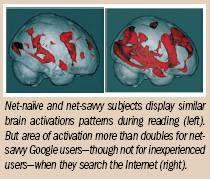Google, it does a brain good
Do you google? Relying on the Internet's most popular search engine has become second nature for frequent users.
Do you google? Relying on the Internet's most popular search engine has become second nature for frequent users. For this group, it is obvious that Google is great for finding information, but is the intellectual exercise healthy for the brain? Functional MRI research conducted by Dr. Gary Small at the University of California, Los Angeles suggests that it is.
"There is no absolute proof for the 'use it or lose it's theory of the brain, but it is certainly possible," Small said in an interview. "It may be that web searching could be a brain training activity."

The director of UCLA's Memory and Aging Research Center came to this conclusion after performing blood oxygenation level-dependent fMRI on the brains of 12 net-savvy and 12 net-naïve subjects.
Separate scans were performed on these cognitively normal adults (aged 55 to 78 years) while they were reading a book and searching the web for specific topics.
The magnitude and extent of activation were similar for both groups during reading (left image). But the net-savvy group demonstrated more than two times more activation than the net-naïve group during Internet searches. Activation was more pronounced in the frontal pole, anterior temporal region, anterior and posterior cingulate, and hippocampus-regions associated with decision making, complex reasoning, and vision (right image).
The study was published in February in the American Journal of Geriatric Psychiatry (2009;17[2]:116-123).
New MRI Research Explores Links Between Waist-to-Hip Ratio and Memory in Aging
March 13th 2025Researchers found that a higher waist-to-hip ratio in midlife was associated with higher mean diffusivity in 26 percent of total white matter tracts in the cingulum as well as the superior and inferior longitudinal fasciculus.
Is MRI Contrast Enhancement Necessary for Long-Term Monitoring of Diffuse Glioma?
March 4th 2025In a comparison of contrast-enhanced T1-weighted (CET1w) MRI (and T2-weighted MRI/FLAIR imaging, researchers found that only three out of 82 cases of glioma progression were solely detected with CET1w MRI.